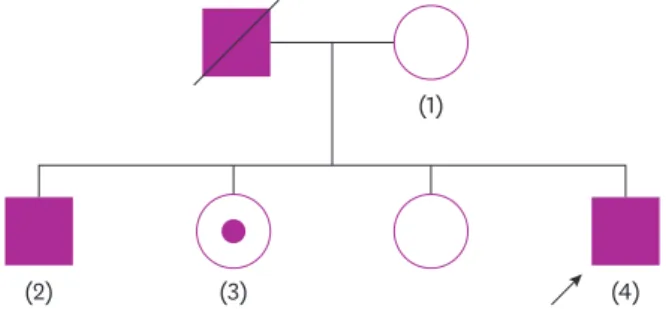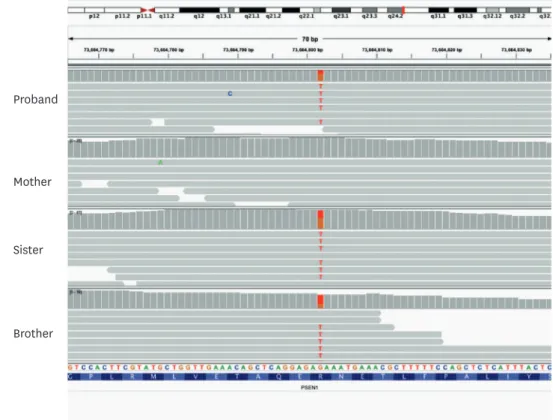33
Familial Alzheimer disease (AD) is caused by mutations in the PSEN1, PSEN2 and APP genes.
In rare cases, mutations in ABCA7 and SORL1 also show familial AD, depending on their positions in the proteins.
1,2About 5% of early onset AD (EOAD) are caused by mutations of these 5 genes.
3The clues about having causal gene mutations in EOAD are the age of onset and number of EOAD patients in their families. If EOAD patients have one or more relatives with EOAD, 77% of their families have the causal gene mutations.
4In sporadic cases, the causal gene can be identified at a very low rate of 17.9% for patients of age at onset under 50 and 1.2% for those over 50.
4Familial EOAD cases have been reported due to a loss of function mutations that seriously alter the function of the ABCA7 gene.
2The mutations in genes other than ABCA7 make it difficult to determine pathogenicity. In this letter, we report a case of the R278I mutation in PSEN1, which has not been reported in Korean familial EOAD patients.
A 49-year-old man visited our dementia center complaining of memory impairments.
According to the patient's report, he felt mild forgetfulness for about 10 years. In 2018, he began to easily forget the stories that he heard. Sometimes, he could not remember what he had done at work. When he talked with friends, he often could not remember the important previous events. His friends advised him to visit clinics. As a computer programmer, there is no problem in working. Driving, money management, hobbies and social relations are maintained as before. No neurological findings were observed. According to neuropsychological tests, his clinical diagnosis was multiple domain amnestic mild cognitive impairment (MCI). He remembered that his father had dementia in his early sixties, and his brother also developed dementia in his early fifties. His mother has still normal cognition to date. The patient has 2 sisters who are 58 and 55 years old, and neither of them have ever complained of memory impairment (Fig. 1). No atrophy was observed on magnetic
Dement Neurocogn Disord. 2020 Mar;19(1):33-35https://doi.org/10.12779/dnd.2020.19.1.33 pISSN 1738-1495·eISSN 2384-0757
Letter to the Editor
Received: Oct 12, 2019 Revised: Nov 17, 2019 Accepted: Nov 22, 2019 Correspondence to Jun Hong Lee
Department of Neurology, Dementia Center, Stroke Center, National Health Insurance Service Ilsan Hospital, 100 Ilsan-ro, Ilsandong-gu, Goyang 10444, Korea.
E-mail: jhlee@nhimc.or.kr Seong Hye Choi
Department of Neurology, Inha University School of Medicine, 27 Inhang-ro, Jung-gu, Incheon 22332, Korea.
E-mail: seonghye@inha.ac.kr
© 2020 Korean Dementia Association This is an Open Access article distributed under the terms of the Creative Commons Attribution Non-Commercial License (https://
creativecommons.org/licenses/by-nc/4.0/) which permits unrestricted non-commercial use, distribution, and reproduction in any medium, provided the original work is properly cited.
ORCID iDs Jong Hun Kim
https://orcid.org/0000-0002-2594-1048 Seong Hye Choi
https://orcid.org/0000-0002-4180-8626 Jun Hong Lee
https://orcid.org/0000-0002-5023-6009 Funding
This study was supported by intramural funds from Ilsan Hospital, National Health Insurance Service.
Jong Hun Kim ,
1Seong Hye Choi ,
2Jun Hong Lee
11 Department of Neurology, Dementia Center, Stroke Center, National Health Insurance Service Ilsan Hospital, Goyang, Korea
2Department of Neurology, Inha University School of Medicine, Incheon, Korea
The R278I Mutation of PSEN1 in the Familial Alzheimer Disease
https://dnd.or.kr
(2) (3) (4)
(1)
Fig 1. The pedigree of the family in the case. The arrow indicates proband, and the subjects with numbers were sequenced.
Conflict of Interest
The authors have no financial conflicts of interest.
Author Contributions
Conceptualization: Kim JH, Choi SH, Lee JH;
Data curation: Kim JH; Formal analysis: Kim JH; Funding acquisition: Kim JH; Investigation:
Kim JH; Methodology: Kim JH; Project administration: Kim JH; Resources: Kim JH; Software: Kim JH; Supervision: Lee JH;
Visualization: Kim JH; Writing - original draft:
Kim JH, Choi SH, Lee JH; Writing - review &
editing: Kim JH, Choi SH, Lee JH.
resonance imaging (MRI) and there was no subcortical ischemic change. On the Vizamyl TM (flutemetamol F18; GE healthcare, Chicago, IL, USA) amyloid positron emission tomography, there was amyloid deposition in the cerebral cortex. The Institutional Review Board approved the genetic study of the family (IRB approval number: 2016-02-010). We performed whole exome sequencing and found a mutation in the proband, which changed guanine into thymine of hg19 73664802th nucleotide in chromosome 14. The mutation changed arginine (R) into isoleucine (I) in 278th amino acid of PSEN1. The R278I mutation is found also in his demented brother and sister, who has normal cognition to date (Fig. 2).
This familial case is the first reported R278I mutation of PSEN1 in Korea. However, the mutation was reported in one family in the foreign country.
5The reported patients showed cognitive impairment accompanied by language impairment. The clinical diagnosis was progressive non- fluent aphasia. A similar R278T mutation of PSEN1 was reported to be associated with spastic paraparesis.
6In contrast, the patient in this letter has not shown any neurological symptoms.
There may be three possibilities. Now, proband is in the MCI stage and different symptoms may develop later. There may also be unknown genetic cofactors related with diverse phenotypes.
Finally, epigenetic and environmental factors can cause various symptoms.
The 278th codon is located in the sole cytoplasmic active domain for pathogenic mutations.
Most of pathogenic mutations of PSEN1 are located in the transmembrane domains.
7The 278th amino acid of PSEN1 lies in the cytoplasmic domain, which forms the gamma-secretase complex.
8The mutations in that domain are expected to alter the function of gamma- secretase and generate Aβ42 amyloid.
34 https://doi.org/10.12779/dnd.2020.19.1.33
Familial Alzheimer Disease Due to PSEN1 Mutation
https://dnd.or.kr
Proband
Mother
Sister
Brother
Fig. 2. Integrative genome browser (https://software.broadinstitute.org/software/igv/) view. The proband, sister and brother had chr14:73664802:G:T (p.Arg278Ile; hg19) mutation. The mother, who had normal cognition, did not have the mutation.
The white matter hyperintensities (WMH) are related with locations of PSEN1 mutations.
Although the post-200th codon mutations are related with occipital WMH,
9the proband's MRI did not show the WMH. The severity of WMH are correlated with age. Therefore, we cannot determine if the R278I mutation of PSEN1 tend to cause WMH, yet.
The missense mutations are the most common mutations in humans.
10The clinical information from family studies are strong evidence to determine pathogenicity of the mutations.
11The foreign free AD mutation database (https://www.molgen.ua.ac.be/
ADMutations/) was closed and we need to pay in order to use the database. In Korea, there must be only a limited number of families with PSEN1 mutations. Therefore, discovering mutations for Korean EOAD and reporting the results will help in diagnosing EOAD patients.
REFERENCES
1. Nicolas G, Charbonnier C, Wallon D, Quenez O, Bellenguez C, Grenier-Boley B, et al. SORL1 rare variants: a major risk factor for familial early-onset Alzheimer's disease. Mol Psychiatry 2016;21:831-836.
PUBMED | CROSSREF
2. Steinberg S, Stefansson H, Jonsson T, Johannsdottir H, Ingason A, Helgason H, et al. Loss-of-function variants in ABCA7 confer risk of Alzheimer's disease. Nat Genet 2015;47:445-447.
PUBMED | CROSSREF
3. Cruchaga C, Haller G, Chakraverty S, Mayo K, Vallania FL, Mitra RD, et al. Rare variants in APP, PSEN1 and PSEN2 increase risk for AD in late-onset Alzheimer's disease families. PLoS One 2012;7:e31039.
PUBMED | CROSSREF
4. Nicolas G, Wallon D, Charbonnier C, Quenez O, Rousseau S, Richard AC, et al. Screening of dementia genes by whole-exome sequencing in early-onset Alzheimer disease: input and lessons. Eur J Hum Genet 2016;24:710-716.
PUBMED | CROSSREF
5. Godbolt AK, Beck JA, Collinge J, Garrard P, Warren JD, Fox NC, et al. A presenilin 1 R278I mutation presenting with language impairment. Neurology 2004;63:1702-1704.
PUBMED | CROSSREF
6. Kwok JB, Taddei K, Hallupp M, Fisher C, Brooks WS, Broe GA, et al. Two novel (M233T and R278T) presenilin-1 mutations in early-onset Alzheimer's disease pedigrees and preliminary evidence for association of presenilin-1 mutations with a novel phenotype. Neuroreport 1997;8:1537-1542.
PUBMED | CROSSREF
7. Dillen K, Annaert W. A two decade contribution of molecular cell biology to the centennial of Alzheimer's disease: are we progressing toward therapy? Int Rev Cytol 2006;254:215-300.
PUBMED | CROSSREF
8. Takasugi N, Tomita T, Hayashi I, Tsuruoka M, Niimura M, Takahashi Y, et al. The role of presenilin cofactors in the gamma-secretase complex. Nature 2003;422:438-441.
PUBMED | CROSSREF
9. Ryan NS, Biessels GJ, Kim L, Nicholas JM, Barber PA, Walsh P, et al. Genetic determinants of white matter hyperintensities and amyloid angiopathy in familial Alzheimer's disease. Neurobiol Aging 2015;36:3140-3151.
PUBMED | CROSSREF
10. Lek M, Karczewski KJ, Minikel EV, Samocha KE, Banks E, Fennell T, et al. Analysis of protein-coding genetic variation in 60,706 humans. Nature 2016;536:285-291.
PUBMED | CROSSREF
11. Richards S, Aziz N, Bale S, Bick D, Das S, Gastier-Foster J, et al. Standards and guidelines for the
interpretation of sequence variants: a joint consensus recommendation of the American College of Medical Genetics and Genomics and the Association for Molecular Pathology. Genet Med 2015;17:405-424.
PUBMED | CROSSREF
35 https://doi.org/10.12779/dnd.2020.19.1.33
Familial Alzheimer Disease Due to PSEN1 Mutation
https://dnd.or.kr

